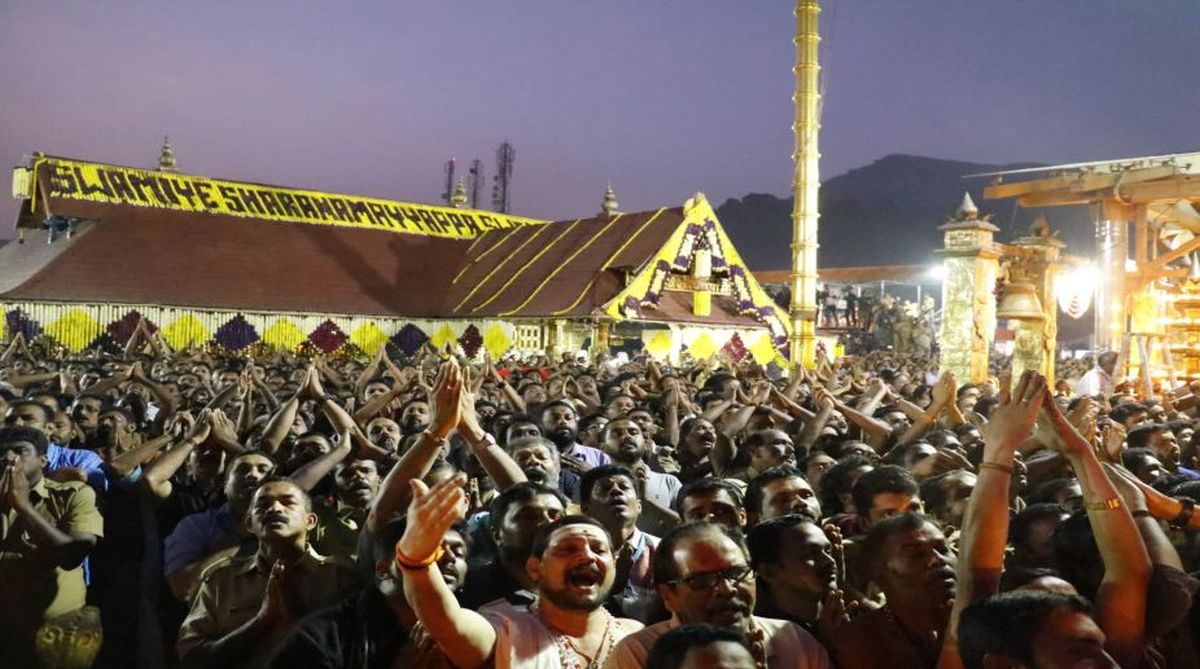Devraj Indra, the king of Swarga while riding on the divine elephant called Airavata came across Sage Durvasa. The spiritually powerful Sage offered Indra a special garland presented to him by Shiva. Indra placed the garland on the trunk of the elephant that threw it on the ground. The enraged Durbasa cursed Indra and all devas to be bereft of all strength, energy, vigor and fortune. The ever-livid sage Durbasa also cursed them to grow grey and wrinkled and lose their divine charm as well. The condition that was applied to regain their divine glamour was that they would have to drink ambrosia or nectar (amrit in Sanskrit) as panacea.
The gods being desperate of retrieving their lost charms took refuge to Lord Vishnu to find some way. Lord Vishnu advised both the gods and the demons to churn the Ocean of Milk called ‘Palazhi’ to yield nectar. But the urn of nectar was whisked away by the demons. Then Lord Vishnu assuming the shape of an enchantress called Mohini recovered the nectar with her captivating mien from the demons and handed it to the gods to regain their lost charms. Lord Shiva heard of Lord Vishnu’s damsel Mohini appearance. He was so infatuated by Mahini’s bewitching beauty that He seduced her. Out of that divinely gay matting, a refulgent child blessed by the splendors of Lord Shiva and Lord Vishnu was born.

The new born child was Dharma Shasta, later called Ayyappa. Lord Shiva enlightened Ayyappa that the purpose of his birth was to kill Mahishi, a demoness. Empowered by the boon bestowed upon her by Brahma, she was perpetrating ruthless atrocities on the gods. Mahishi was assured of almost getting the boon of immortality as she could only be defeated by one born out of the union of two supreme gods Lord Shiva and Lord Vishnu. Lord Shiva transformed Dharma Shasta into an infant with a bell tied round her neck. The infant was left on the bank of the holy river Pampa in the land of Pandalam ruled by eleemosynary king Rajasekhara. The king was then had no son to call the heir of the dynasty.
READ | Sabarimala verdict: Supreme Court to hear revision petitions on November 13
The king during his hunting expedition on the bank of the river heard the wail of a child. To his utter astonishment, the king saw an infant crying on the bank of the river Pampa. Advised by a Brahmin the king brought the child as the heir-apparent of his kingdom. The child was named Manikantan because of the bell around his neck. Under the tutelage of the royal preceptor, Manikantan was brought up as a Kshatriya. No sooner had the king decided to install Manikantan of his heir-apparent than the Dewan incited the queen rousing in her the maternal instinct. She could not bear the pain of her own son being deprived of royal chair. The queen feigned that she had severe headache. The royal physician, who was also the part of the conspiracy hatched by the queen and the Dewan, announced that the queen must drink the milk of leopard to be cured of her severe headache.
Manikantan, the foster child of the royal parents, was assigned with the onus of bringing leopard milk. He filled his cloth bag with twin packets with a coconut with three eyes representing Lord Parameswara, the family deity in one and the other with some eatables. Equipped with bow and arrows, he entered the forest on the bank of the river Pampa. There, along with his retinue of the lieutenants of Lord Shiva came across some sages. A golden temple and a golden throne were built by the sages on a hill called Ponnambalamedu (the hill of golden temple). There he completed his mission for which he descended on the earth. Blessed with the grace of Brahma, a she-buffalo faced demoness called Mahishi was perpetrating atrocities on the gods and usurped the Devloka from Devendra.
READ | Sabarimala verdict supporter Swami Sandeepananda Giri’s ashram attacked in Kerala
Then a male buffalo called Sundar Mahisha was created to woo Mahishi. The sight of Sundara Mahish evoked eroticism in Mahishi who started enjoying worldly pleasures in the company of her consort. But this was not a permanent solution. At last a fierce battle was waged between Mahishi and Ayyappa on the bank of the river Azhutha. He caught hold of the horns of Mahishi, whirled round her and threw her on the ground. Brahma, who witnessed the battle, decided the physical remains of Mahishi to be buried under a heap of stones to prevent them to be grown to such immense height that would obstruct the way of the sun and the moon. More wonders were in store for Ayyappa. After the annihilation of Mahishi, a beautiful lady named Malikapurathamma emerged. Actually, she was a celestial damsel who was cursed to be born with the face of a she-buffalo. She offered her love and expressed her desire to Ayyappa to accept her as his consort.
But Ayyapa being a perennial celibate (Naishtika Brahmachari), turned down her offer. He promised to return to her when the flow of ‘Kanni Swamis’ (new devotees) would stop in his temple. According to Hindu mythology Ayyappa meditated in Sabarimala after killing the powerful demon Mahishi. Restrictions are imposed on the entry of women in the age group of 10 to 50 years in the temple. The presiding deity Lord Ayyappa is a ‘naishtika brahmachari’ (perennial celibate). Women of menstruating age are not allowed to access to the temple on account of ‘purity’. Sabarimala temple is situated on the hilltop named Sabarimal which is about 3000feet above sea level in Pathanamthitta district in the southern part of Kerala. Sabarimala got its name from ‘Shabari’, a devotee who did rigorous penance with the intention of meeting Lord Rama. The temple is dedicated to Lord Ayyappa who is regarded the synthesis of Lord Shiva and Lord Vishnu. According to folklore Lord Parasurama placed the deity at the base of Sabari Hills. Dharma Shasta another name of Lord Ayyappa is also regarded as Lord Buddha. Sabarimala Temple is an incarnation of religious tolerance. People irrespective of cast, creed and color are entitled to enter the temple.
READ | What is the Sabarimala temple case?
Even there is a shrine dedicated to Vavar (a Sufi), an ardent devotee of Lord Ayyappa, in the vicinity of Sabarimala Temple. Makara Vilakku, a holy light on the close by hill and a sign of divine presence, is seen from the temple. Annual festivals are observed in Sabarimal from November to mid-January. The two major festivals are Mandal Puja and Makar Sankranti Puja. Then the temple is visited by thousands of devotees who observe complete abstinence from mundanity for forty one days. It is said the second largest seasonal pilgrimage after Mecca in Saudi Arabia.
The devotees observe celibacy for forty one days. Devotees take a holy bath in the sacred river of Pampa before starting their pilgrimage. It is considered that the river Pampa washes away all the sins of the devotees to purge them. Conventional offerings paid to Lord Ayyappa are ghee, camphor and rice. Besides, when the devotees get to the temple steps, they break the coconut to propitiate the God.
The Supreme Court’s recent verdict recognizing the constitutional right of the women of all ages to enter Sabarimala temple in Kerala and pray like men without being discriminated is undoubtedly a landmark one. The bench’s observation has appropriately snubbed gender discrimination. It commented, “When a man can enter, a woman can also go. What applies to a man, applies to a woman also.” Despite all these, it is not easy to do away with all the deeprooted religious notions and rituals embedded in the psyche of the devout masses. Ironically, the sole woman Justice of the five-judge Constitutional bench Indu Malhotra dissented. Above all, a large number of women do not support Sabarimala Temple to be accessed by girls of all ages. In this regard an observation of Justice Malhotra is significant. “A balance needs to be struck between religious beliefs on one hand and cherished principles of non-discrimination and equality laid down by Constitution on the other












